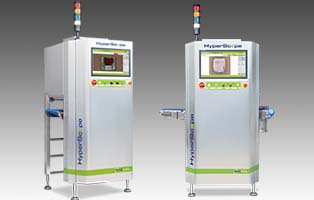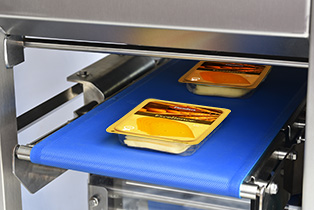
Engilico announces a new evolution of the HyperScope® system for seal inspection of plastic or cardboard trays, pots and other thermoformed packages. HyperScope® uses hyperspectral imaging to detect seal contamination with high contrast, even with printed film. The inspection system features GPU-accelerated artificial intelligence, which enables high-precision seal area detection in real-time, regardless of the package orientation, packaging material, layout or size. Another new improvement is the (optionally) integrated conveyor belt that can be completed with an integrated reject unit. Combining these improvements, HyperScope® serves as a fully integrated solution for high-accuracy rigid package inspection.
 Hyperspectral cameras capture information from a larger part of the electromagnetic spectrum including infrared wavelengths that penetrate through thin plastic or paper top films. The particular strength of this camera type is that contamination in the seal can be reliably detected with much higher contrast than traditional vision cameras, even through printed films. Hyperspectral imaging, therefore, unlocks new inspection possibilities where classic imaging often falls short, e.g. on printed film packages which are often used in luxury packaging, on packaging with opaque backings or in applications where the seal contamination is difficult to detect due to limited contrast. An example of the latter are packages of the same color as the packaged product.
Hyperspectral cameras capture information from a larger part of the electromagnetic spectrum including infrared wavelengths that penetrate through thin plastic or paper top films. The particular strength of this camera type is that contamination in the seal can be reliably detected with much higher contrast than traditional vision cameras, even through printed films. Hyperspectral imaging, therefore, unlocks new inspection possibilities where classic imaging often falls short, e.g. on printed film packages which are often used in luxury packaging, on packaging with opaque backings or in applications where the seal contamination is difficult to detect due to limited contrast. An example of the latter are packages of the same color as the packaged product.
In-line seal inspection using hyperspectral imaging is challenging – as packages entering the HyperScope® system can, for example, have different orientations on the conveyor belt. Moreover, the package surface might also be slightly deformed, especially when lighter materials are used – a trend nowadays in order to reduce plastic waste. Since contamination only needs to be detected in the sealing area, it is particularly important to detect this region with high accuracy. HyperScope® relies on Artificial Intelligence for this task: the seal area is automatically determined, regardless of package orientation, deformation degree or number of tray compartments.
The detected area is then further analyzed for contamination presence followed by numerous post-processing filtering (e.g. seal breach detection, reject area filtering, …). Finally, the (soft) decision criteria to accept or reject the package based on the post-processing output is computed. Note that the latter is important because not every contamination in the seal is equally critical for a customer: seal breaches always require a rejection, whereas smaller seal contamination that do not create a leak could be retained.
As every package is inspected individually, all these computations and analysis need to be in pace with fast production speeds. Therefore, the new HyperScope® system is equipped with a ’big data’ optimized processing architecture including a powerful GPU. The system can inspect up to 160 packages per minute, a speed that is well aligned with food production lines. Depending on the needs, available space and layout of the customer’s production line, the system can be equipped with an integrated 300 mm wide conveyor belt and/or reject unit.
equipped with a ’big data’ optimized processing architecture including a powerful GPU. The system can inspect up to 160 packages per minute, a speed that is well aligned with food production lines. Depending on the needs, available space and layout of the customer’s production line, the system can be equipped with an integrated 300 mm wide conveyor belt and/or reject unit.
As Dr. Verbanck, Engilico’s Engineering Director comments: “We are very excited to introduce this new enhanced HyperScope® system. The new design and flexibility of the system enables easy integration into new and existing production lines. In addition, we see that the use of artificial intelligence brings us unprecedented inspection functionality. Engilico® will further use this technology to develop other new exciting capabilities.”
Interested food producers are invited to remotely follow a live, interactive demonstration of the HyperScope® system, inspecting samples of their own products with seal defects. A live video-meeting is consequently organized to see HyperScope® at work.
Contact us to learn more about HyperScope or to schedule a demonstration
